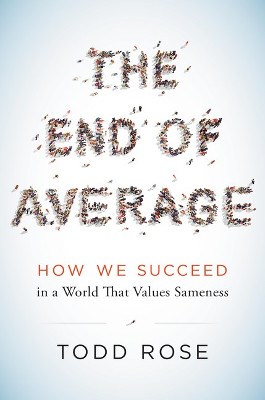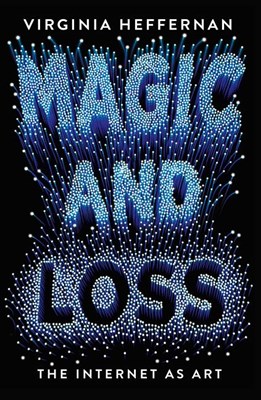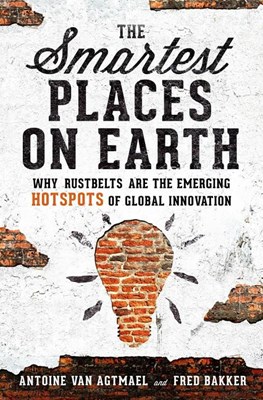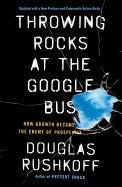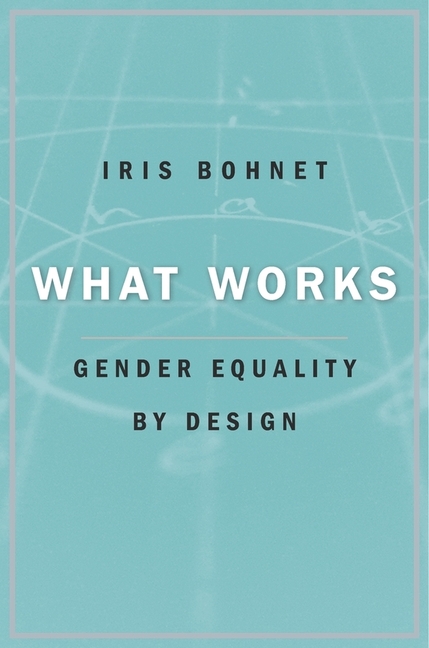Inside the Longlist: Big Ideas & New Perspectives
December 21, 2016
Big ideas and new perspectives someday become, once enacted, status quo. It will take a while, but the first step is often powerful voices writing powerful books.
In the last three years, I’ve led the discussion on three different categories for our annual business book awards. Without question, Big Ideas & New Perspectives was the most difficult category for me to narrow down and cull books from for those discussions began. For one, the category is stacked with established voices with tremendous track records. Secondly, the kind of books that make up the category are inherently attractive; people want to read the books that have the most potential to not only change a company or industry, but to change the world on a grand scale. Big ideas change the world. New perspectives reframe how we think about the world we know and how it should be going forward.
People reading business books aren’t doing so because they want to repeat their steps day in and day out. We read them to change or to make change. These five books help us get there.

 Todd Rose tackles an issue—standardization—that is so embedded into our culture that breaking through is going to take great focus and determination. We actively perpetuate routines and rules that breed average people producing average results. In education we have standardized testing. In business we create products and services that appeal to the most people possible, but ultimately solve the specific needs of exactly no one human being.
Todd Rose tackles an issue—standardization—that is so embedded into our culture that breaking through is going to take great focus and determination. We actively perpetuate routines and rules that breed average people producing average results. In education we have standardized testing. In business we create products and services that appeal to the most people possible, but ultimately solve the specific needs of exactly no one human being.
So what are the solutions? Rose offers plenty in The End of Average, but one is to move beyond the kind of deductions that big data provide and into solutions gleaned by even more massive amounts of information, mostly by adding to group data the specific identifiers of individuals.
Speaking of one of Rose's examples pertaining to health care, The New York Times pointed out:
(This premise may remind the reader of the one underlying the nascent discipline of “personalized medicine,” whose proponents suggest that analysis of an individual’s genetic makeup may guide health care decisions far more precisely than big group studies do.)
The End of Average is a book that, at first, may not seem like a tectonic shift—or a big idea—but upon further examination reveals a massive change to how we approach life, business, education, and all endeavor.
 Beauty is not often a word associated with a business book, but Magic and Loss is a stunning book, a beautiful display crafted by Virginia Heffernan’s exquisite mind. In Heffernan’s own words:
Beauty is not often a word associated with a business book, but Magic and Loss is a stunning book, a beautiful display crafted by Virginia Heffernan’s exquisite mind. In Heffernan’s own words:
For years technology had seemed to be the masculine form of the word culture. If you wanted to sell men on a culture story, you did well to frame it as a tech story—a story about the plumbing or stock price of Netflix rather than a story about the pixels that constitute ‘Bloodline.’ Technology is built stuff that aims to be elegant and engaging. Apps are founded on science in the same sense that a watercolor is founded on science, where the chemistry of pigments and the physics of brush strokes are the science. But the resulting painting, if successful, hints at transcendence or at least luminous silence, something whereof we cannot speak.
Heffernan does a marvelous job at discussing what the internet has taken away from us—mostly tangible, hands on, and face-to-face experience—but taking the bite out of it. The loss we experience with change doesn’t need to breed resentment, precisely because there is also a lot of magic in change. And as technology swiftly changes again, our core won’t be so shaken if we can mourn at the same time our eyes are wide with both aesthetic appreciation and the wonder of the new.
 Antoine van Agtmael and Fred Bakker wrote a much different book than Heffernan, but one that shares a similar base. That base is the anxiety we feel when looking out at a world we don’t understand, a world that perhaps misplaced our best interests, or at the very least hasn’t yet figured out how best to serve them again.
Antoine van Agtmael and Fred Bakker wrote a much different book than Heffernan, but one that shares a similar base. That base is the anxiety we feel when looking out at a world we don’t understand, a world that perhaps misplaced our best interests, or at the very least hasn’t yet figured out how best to serve them again.
I’ve spent hours trying to condense The Smartest Places on Earth, but I kept coming back to Bhaskar Chakravorti’s review for the New York Journal of Books. In it, Chakravorti frames the review in our current political and economic climate, and how appropriate this book is for where the West sits at the tail end of the industrial revolution. Then comes the money quote:
According to Agtmael and Bakker, the West will be the world’s next emerging market; in fact, the many decaying rustbelts in places such as Akron or Eindhoven or Dresden are sources of future competitive advantage; they shall rise (or have already risen) as the next hubs of innovation and growth.
Why should we believe this? The logic seems intuitive enough. All the fallow resources left over from the decay of an industrial past are prime candidates for reuse. To this you add a few key ingredients: a major research university, a major corporation, an ecosystem built on trust and collaboration that also acts as a magnet for talent, a “connector,” and a mystery ingredient that might best be described as the “prince’s kiss,” and voilà: a new brainbelt awakes. This is the core message of the book.
Couldn’t have said it any better myself… literally.
 If Magic and Loss is way to grapple with the rapid growth of the digital world, and The Smartest Places on Earth is how some industrial hubs are bouncing back back from its affects, Throwing Rocks at the Google Bus is a flat-out warning. Douglas Rushkoff argues that the pace at which the digital economy is growing is unsustainable, and will almost surely “derail not only the innovative capacity of our industries, but also the sustainability of our entire society” if it is not fundamentally questioned and systematically restructured. And he’s got plenty of ideas on both scores.
If Magic and Loss is way to grapple with the rapid growth of the digital world, and The Smartest Places on Earth is how some industrial hubs are bouncing back back from its affects, Throwing Rocks at the Google Bus is a flat-out warning. Douglas Rushkoff argues that the pace at which the digital economy is growing is unsustainable, and will almost surely “derail not only the innovative capacity of our industries, but also the sustainability of our entire society” if it is not fundamentally questioned and systematically restructured. And he’s got plenty of ideas on both scores.
What all five books make clear is that smart change is incredibly difficult, but possible nonetheless. If we had to rank which big idea or new perspective will be the most difficult to realize on a grand scale, it would probably be a tie between Rushkoff’s and Iris Bohnet’s. They are the most challenging precisely because these changes require entrenched power structures to first admit that the structure they created or operate doesn't serve society well anymore, and then actually do something about it.
In this case, the lords of Silicon Valley are going to have to or be forced to see that their overemphasis on growth is going to result in an explosive, self-created bursting of the bubble.
Everyone from the start-up to the investor and financier will have to accept that giving up their monopoly, and more precisely, how they operated to achieve that monopoly, is harmful and destructive. It won’t be easy, but with people like Douglas Rushkoff banging on their doors, there is at least hope.
 Finally, Iris Bohnet’s book presents perhaps the most comprehensive roadmap ever written to making equality in the workplace a reality. In What Works, Bohnet acknowledges that we must continue to chisel away at overtly discriminatory behavior facing women and minorities, but writes that real change will happen only when we systematically design against subconscious biases. Bohnet spends significant time identifying and explaining these subconscious biases, not only in our structures, but in ourselves. Using multiple research studies, she describes the ways in which our decision-making is hindered by our habits, and how—if we design strategies to circumvent our biases or remap our brains—we can remove any detrimental defensiveness out of the effort and instead follow a plan.
Finally, Iris Bohnet’s book presents perhaps the most comprehensive roadmap ever written to making equality in the workplace a reality. In What Works, Bohnet acknowledges that we must continue to chisel away at overtly discriminatory behavior facing women and minorities, but writes that real change will happen only when we systematically design against subconscious biases. Bohnet spends significant time identifying and explaining these subconscious biases, not only in our structures, but in ourselves. Using multiple research studies, she describes the ways in which our decision-making is hindered by our habits, and how—if we design strategies to circumvent our biases or remap our brains—we can remove any detrimental defensiveness out of the effort and instead follow a plan.
For a deeper dive into What Works, read our General Manager’s feature from April of this year. In it, Sally wrote:
It's true that What Works is a complicated book. Not because Bohnet isn’t a clear writer—she is both precise and engaging—and not because the methodology she presents is particularly daunting in terms of execution. It’s complicated because gender equality is complicated, especially if we want to make sure we don’t resort to knee-jerk name-calling or victim-blaming. It’s complicated because we simply aren’t aware of all the ways in which we are biased. (And, it’s to Bohnet’s credit that she doesn’t lose sight of other minorities who face similar and/or additional disadvantages and ages-old biases despite her focus on gender.)
Like I said, this is going to be hard as all get out to enact and execute, because not only does the power structure have to become self-aware, we the people who want to fight for change also have deeply entrenched biases that have to be confronted.
In the end, I hope all these big ideas and new perspectives someday become, once enacted, status quo. It will take a while, but the first step is often powerful voices writing powerful books. And this year, for this category, these are the most powerful.


